
Photoshop has been a part of every web designer's life since they picked up their first mouse.
On February 10th, 2010, Photoshop turns twenty. To mark this anniversary, we've come up with an article that takes you through the evolution of Photoshop from its modest beginnings as a bundled program sold with scanners to its current version.
For each version and major feature listed, we couldn't help but think "did Photoshop ever exist without that feature?".
Some of the minor details are fun too, such as the one-liner Easter Eggs that Photoshop developers hid in some versions and the fact that the most current versions of Adobe Photoshop CS are equipped with anti-counterfeiting measures for multiple world currencies.
Please join us in thanking the Knolls and Adobe for making all of our lives more awesome, every day.
Photoshop: Origins

One of the most impressive things about the company is the fact that one gifted family, consisting of an engineering prof, a PHD engineering student, and a talented special effects whiz working at Industrial Light and Magic came up with the core idea of Photoshop.
Thomas Knoll, the PHD student, is still heavily involved with Photoshop years later.
Glen Knoll was a college professor with two sons and two hobbies; computers and photography.
He had a darkroom in his basement, and an Apple II Plus that he was allowed to bring home from work.
Thomas Knoll adopted his father's photography habit throughout high school, while his brother, John Knoll, purchased one of the first Macs available to the public.
Fast forward to 1987: Thomas Knoll was a PHD student studying Engineering at the University of Michigan. His brother was working at Industrial Light and Magic.
Thomas Knoll wrote a subroutine for a program to translate monochrome images on his monitor to grayscale.
The successful subroutine led Knoll to create more and very soon he had a number of processes for achieving photographic effects on digital images.
After his brother John saw what Thomas was doing, he recommended that Thomas turn what he was doing into a full-featured image editor.
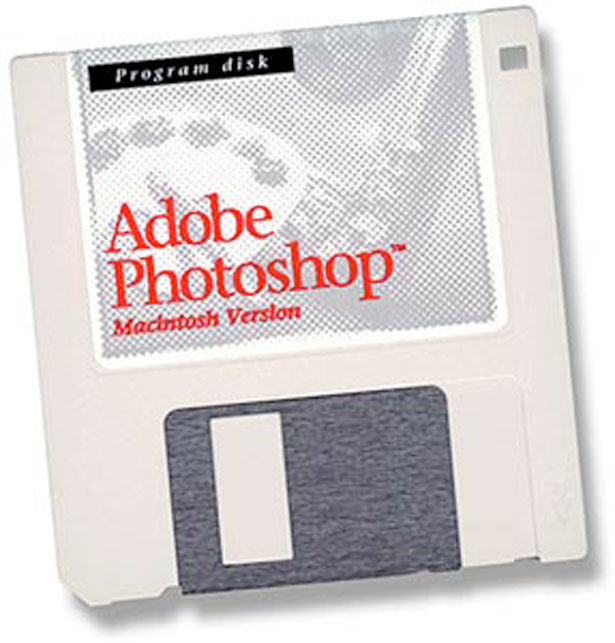
The combination of Thomas' programming abilities with John's pragmatic design background led to a collaboration between the two brothers to develop more processes and improve on the initial application.
Even though the process led to interruption in Thomas' thesis work, the brothers released "Image Pro" in 1988.
John suggested that they begin to sell Image Pro as an application.
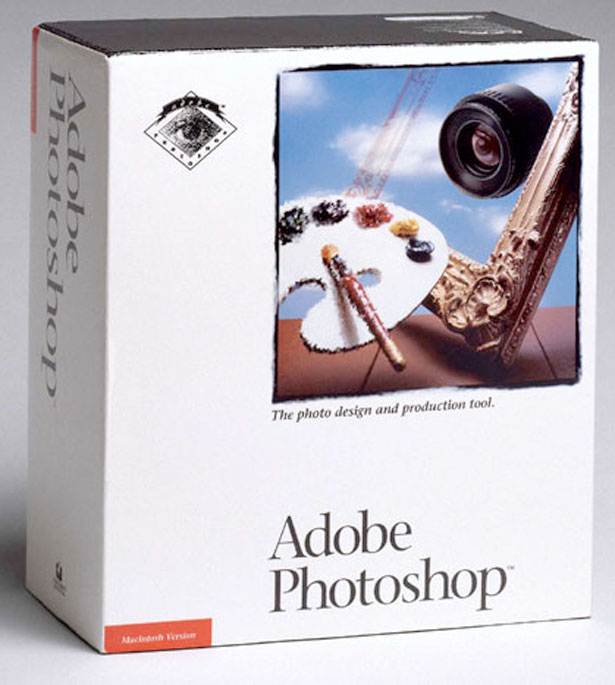
Within six months, the brothers had a partnership with a company that manufactured scanners, Barneyscan.
They purchased 200 copies of the program to ship with their scanners.
They called on Supermac and Aldus, but were turned away at both, a move that Aldus would come to seriously regret.
Shortly after, the Knoll brothers struck gold when they won over Adobe management with their product, and formed a licensing partnership with Adobe that was to launch their software and Adobe into the stratosphere.
In February of 1990, Adobe 1.0 was released.
This video, shot in January of 2010, is a great interview with John Knoll about the early days of Photoshop:
Photoshop Through the Years; Version Changes
We've included major changes within each version and some minor ones. This is meant to be a fun stroll down memory lane rather than a complete version catalogue.
If you have a particular version change that got your hackles up or a feature that you'd to mention, feel free to add it to the comments section.
1990 - Photoshop 1.0
John Knoll, Thomas' brother, wrote "special effects" for the program which were frowned upon by Adobe staff as being too "gimmicky". Thomas and John found a way to sneak them into Photoshop as plugins, giving rise to what is now a huge cottage industry in add-ons to the popular program.
John and Adobe staff constantly pushed Thomas to make improvements until the final product shipped.
The first version of the Photoshop splash screen features just four Photoshop programmers. In subsequent versions, more and more names are added to the list. In more recent versions, a limited number of Adobe VIP's appear in the splash screen.
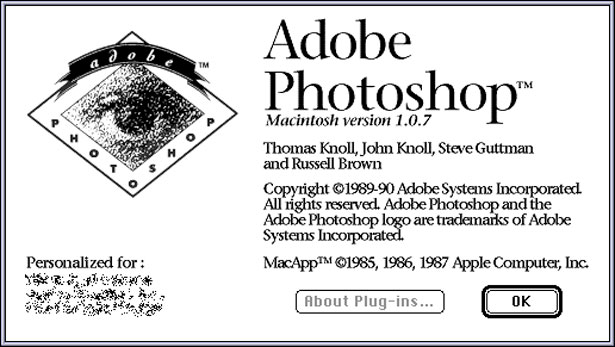
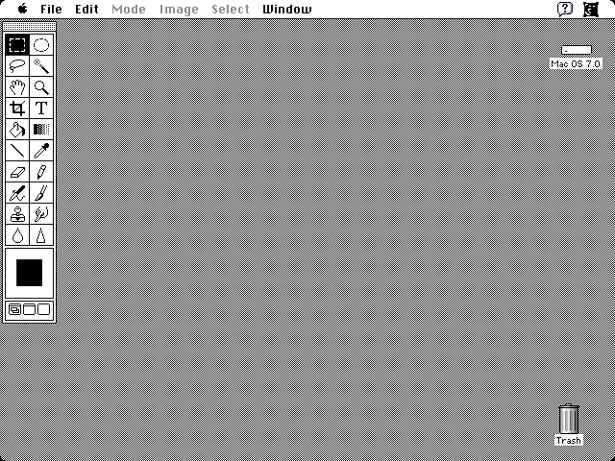
1991 - Photoshop 2.0
Photoshop 2.0 included the Path feature, which allowed users to trim around an object easily and to save that path for future use. This feature was added by a second engineer, Mark Hamburg, that Adobe hired to work on the application.
Up until 2.0, Thomas Knoll was the only engineer working on it. Adobe called Mark the "Path Man". 2.0 also featured rasterizing for Illustrator files, support for CMYK colour which led to widespread Photoshop adoption by the printing industry, and the Pen.
Photoshop 2.0 also required 4 megabytes of RAM to run rather than 2, which really helped program stability.
Photoshop 2.5, released in 1992, was notable for being the first release for the Windows operating systems.The code had to be completely changed in order to accomplish this goal which meant that the first effort was slow going.
16-bit file support and palettes were added to this version as well. The initial Windows release had a "memory bug", a bug which actually saw Mark Hamburg offer to make house calls. The patched version was released as 2.5.1. Filters got their own menu in 2.5 as well. The workspace shot below is of Photoshop 2.5 for the Mac.
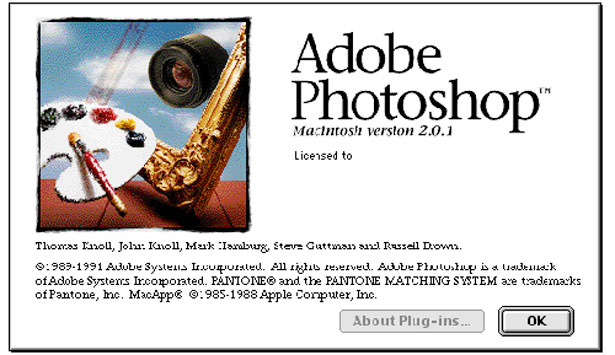
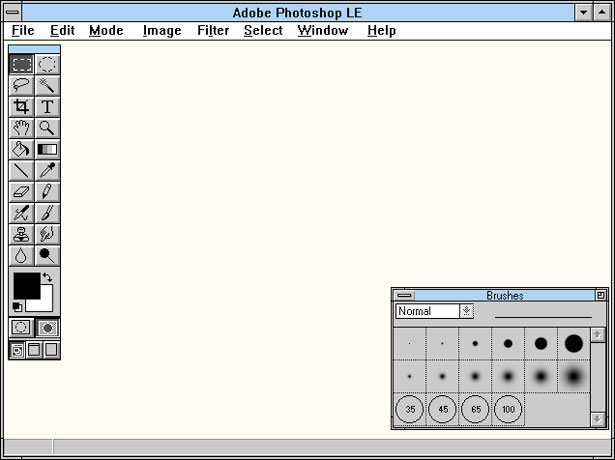
1994 - Photoshop 3.0
The big story for Adobe Photoshop 3.0 was layers. Layers were and are a lifesaver for any marginally complex design.
Prior to their introduction, designers would save different versions of designs so that they could go back and grab them if needed; layers made this practice redundant.
Layers are individual slices of the image that go together to make the final "sandwich" of the image. Different images, such as those used in the image above in the 3.0 splash screen, are assigned their own layers, making it easy to work on those images without tampering with other areas of the image.
Thomas Knoll, the original creator of the program, was responsible for their development. Other engineers made improvements in the program's performance with Power Mac chips and bringing the Windows version up to the same level as the Mac version. Tabbed palettes also had their debut in 3.0.
Adobe engineers included Adobe Transient Witticisms (ATW) with this version. They were little Easter Egg funny one-liners that would appear only when you pressed obscure combinations of keys.
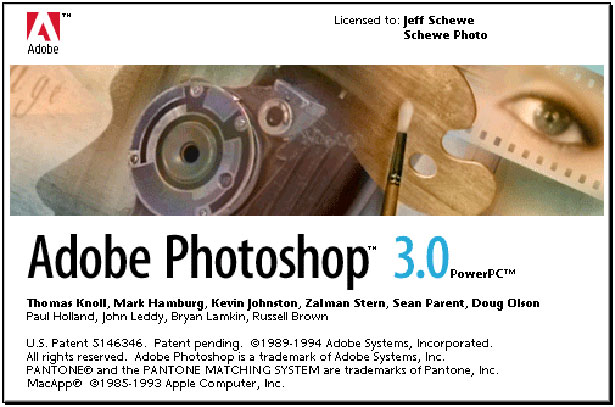
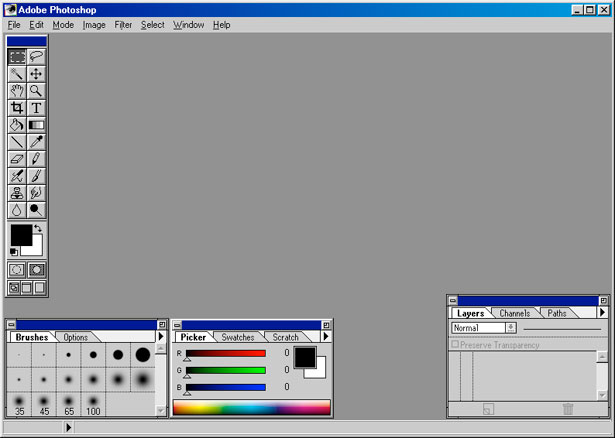
1996 - Photoshop 4.0
Adjustment layers and macros were the two most notable features of Photoshop 4.0.
Adjustment layers allow the designer to apply one effect to a group of layers. Macros, or actions in Photoshop speak, allow you to map a series of commands to one command. This allows you to perform the same operation in much less time if you have a bunch of images to work on.
The most important change to 4.0 was the unification of the user interface with other Adobe products, a feature which Adobe has stayed consistent with right up to present-day incarnations of the program. This meant a less steep learning curve for Adobe products, a blessing for those who got their start with Photoshop 4.0.
Loyal users of Photoshop were not amused with the redesign, the common question from the community being "Why did you break Photoshop?".
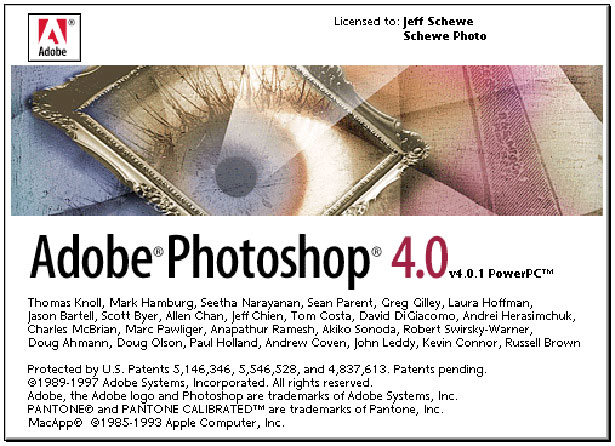
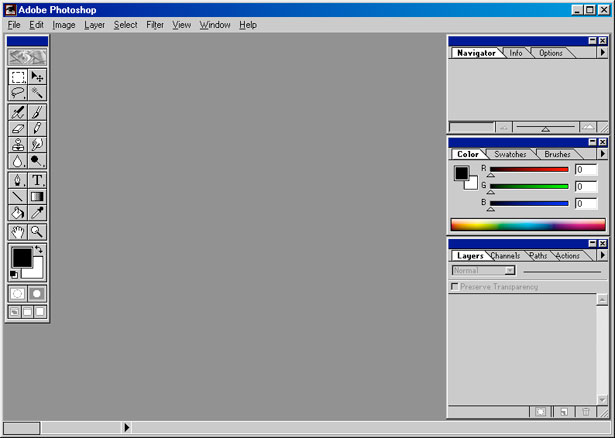
1998 - Photoshop 5.0
The two most important features released with 5.0 were editable type and the ability to undo actions multiple times in the "History" palette.
Previous versions of Photoshop allowed text to be added, but the fuzzy rasterized type didn't make for pretty magazine mastheads or decent web menus. This was a huge step forward. Multiple undos via the History palette were very helpful, especially since designers were starting to use the new Adobe tools for increasingly complex designs.
Color Management made its debut with 5.0. Like other major changes to Photoshop, it was greeted with equal parts of praise and condemnation. It allowed colors to be managed natively within the application rather than relying on third-party tools that had been used, a huge improvement.
However, it also automatically converted the colors when opening files, a "feature" that engineers quickly eliminated after multiple user complaints. The magnetic lasso tool debuted in 5.0, making selecting areas of an image to work on much easier.
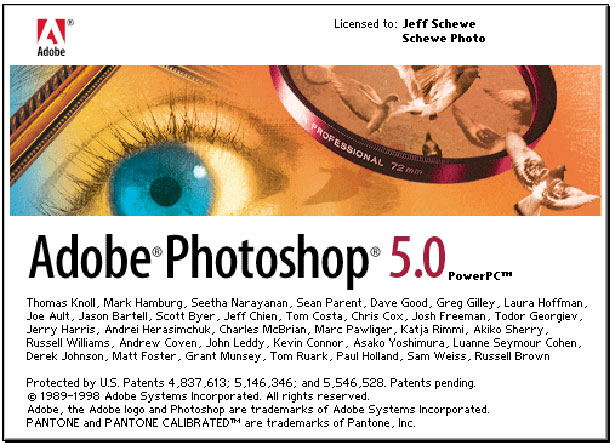
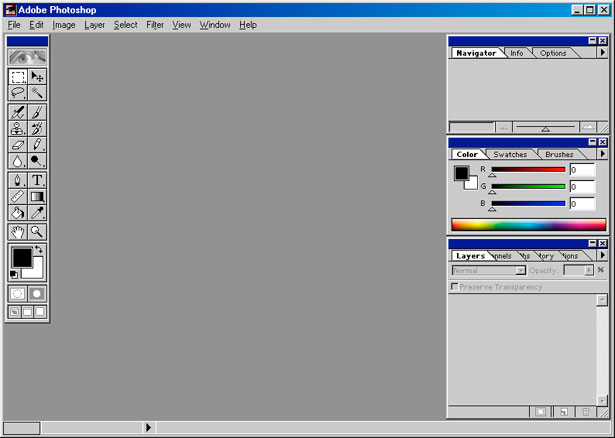
1999 - Photoshop 5.5
Photoshop 5.5 featured the huge time saver, "Save For Web". This feature allows those who choose it to save the image in a preset specifically designed for web use which allows the user to adjust image quality to achieve a smaller image.
Version 5.0 had failed to take the Web into account with all of its other major feature changes on the table. It was also bundled with ImageReady, a standalone program that was purpose-built to edit web graphics.
Most of the features of ImageReady were later incorporated into the full version of Photoshop and the idea of a simpler program was reborn eventually in the form of Photoshop Elements.
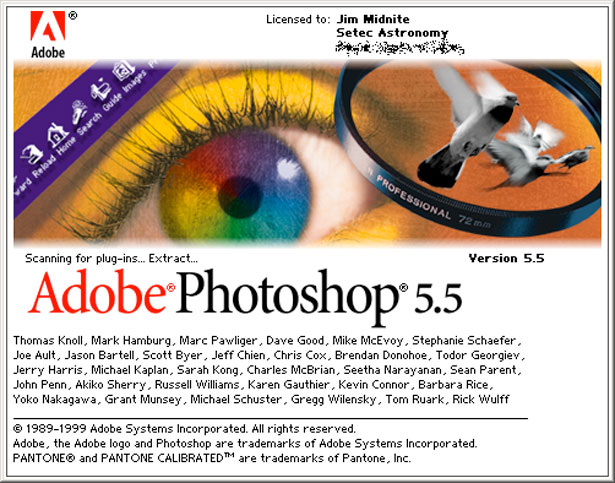
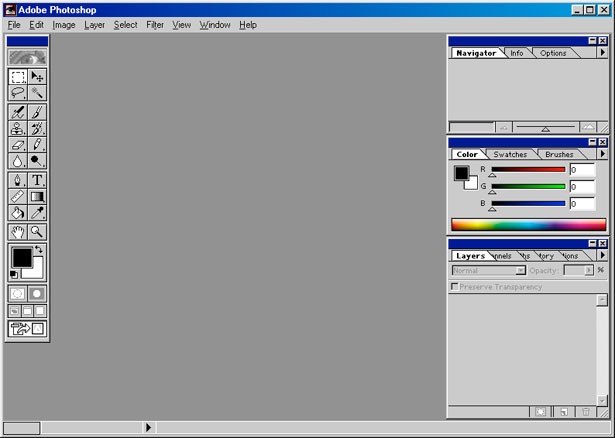
2000 - Photoshop 6.0
The layer styles panel made working with layers even easier in Photoshop 6. Vector shapes were also added in this release; the ability to draw vector shapes such as arrows into a bitmap was lauded by users.
There was also a new custom shapes palette that allowed the user to draw using vector shapes rather than just using lines. Text could also now be typed directly onto a picture, rather than being typed first into a text box.
Multi-layer functions made their first appearance with version 6.0. The Blending Options dialogue was also introduced which made blending various elements of an image much easier. 6.0 separated the crop tool from the marquee tool, making it that much easier to get to this commonly used command.
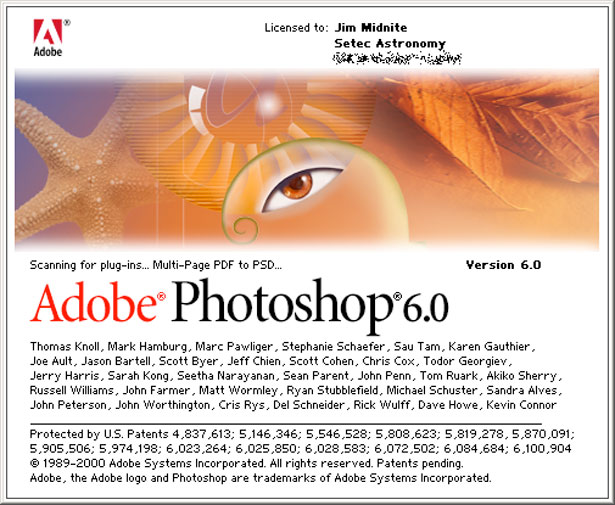
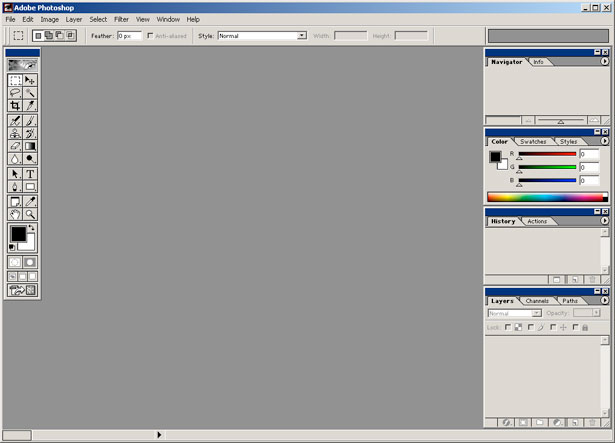
2001 - Photoshop Elements
With the increasing complexity of the tools available to users, Photoshop was risking losing a significant market share that didn't understand or need some of its more advanced tools.
In order to combat this, they released Photoshop Elements in 2001. The new product was a success, and designers continue to recommend it to clients for simple image resizing and other non-design tasks.
While its current interface, shown below, isn't intuitive for those trained in traditional Photoshop, it is highly usable and labeled clearly for the average user. If there are any problems with it in terms of functionality, the simple answer is to upgrade to the full-featured Photoshop.
2002 - Photoshop 7.0
Version 7.0 introduced the healing brush and text that was fully vector-based. More importantly to veteran users, it introduced a new file browser that let designers easily pore through folders to find the graphics that they wanted.
Files within a folder could be renamed using Batch Rename, plus a bunch of other helpful commands that made working with a high volume of files much easier.
Workspaces could also be created and saved, allowing you to save your file locations and groups for future use.
The brush palette also featured a number of changes, including the new healing brush tool, patch tool, and the ability to create custom brushes. Spell check and a find/replace feature rounded out the updates to the text tool.
A number of enhancements were also included for web use, including the addition of rollover effects for images and a web gallery feature.
One of the most important upgrades was under the hood; 7.0 was optimized for use with Mac OS X, virtually eliminating crashes in the middle of working on large files. The tool presets palette let users program presets for commonly performed tasks, increasing efficiency.
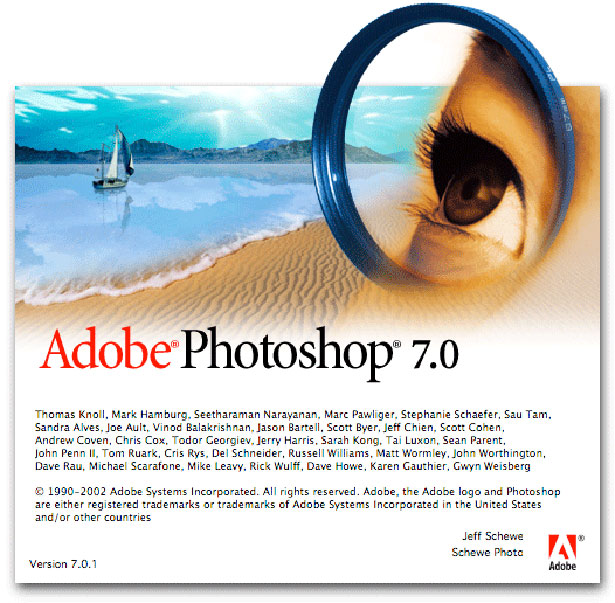
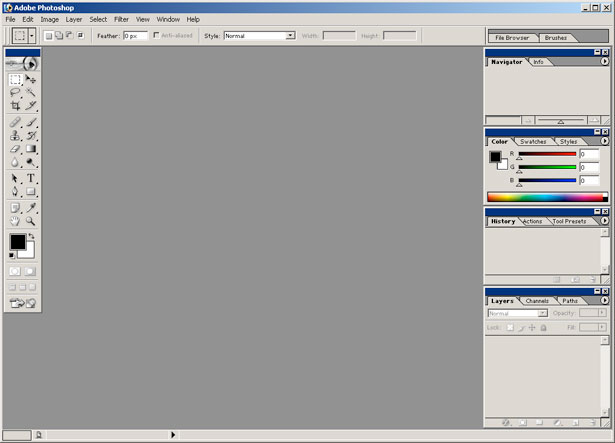
2003 - Photoshop CS
Photoshop CS was the first to employ the CDS (counterfeit deterrence system) which recognized and refused to allow duplication of paper currency.
Scripting support for various web languages, including JavaScript, was also new to this release.
Layer groups were introduced with this version, which allowed various layers to be grouped together for effects to be applied to some and not others.
Improvements to the File Browser made images easier to work with, and the 16-bit and better large file support made CS much easier to work with for designers who constantly worked with larger images and photographers.
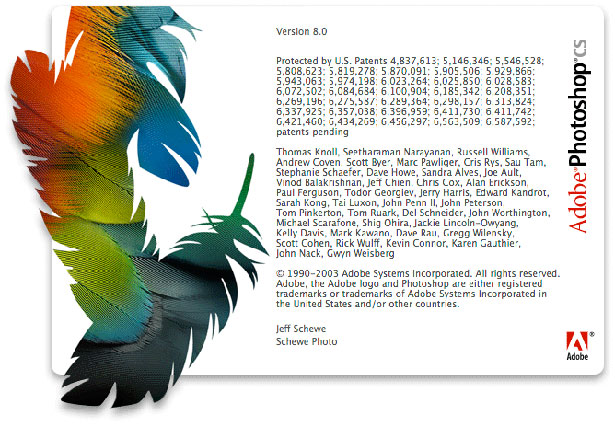
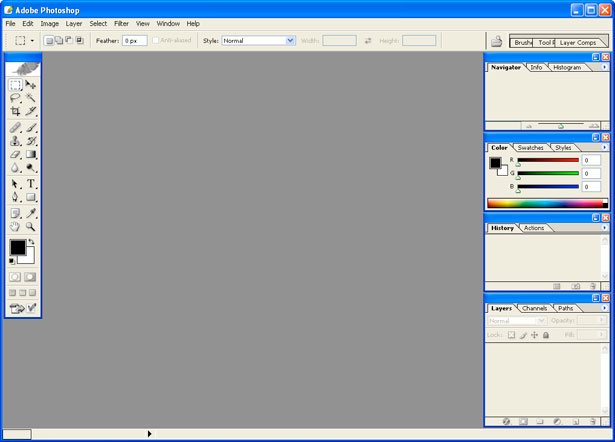
2005 - Photoshop CS2
The red eye removal tool, previously exclusive to Elements, was popular enough to make an appearance in the core version of Photoshop. Smudging options and the ability to select multiple layers also added to the functionality of Photoshop.
The Vanishing Point tool allowed users to edit images in perspective. The largest moment of panic when upgrading to PS2 came for most when they tried to find the Paint Bucket tool, which had been classified under the Gradient tool. There were other significant changes to the UI that prompted one writer to put out this "Where's My Stuff?" column.
Layers and the layers palette were other areas of note. The "links" column was removed because CS2 included a link button rather than the small chains beside each layer. The "Smart Object" feature was introduced, which allows the user to scale a layer up without significant loss of quality.
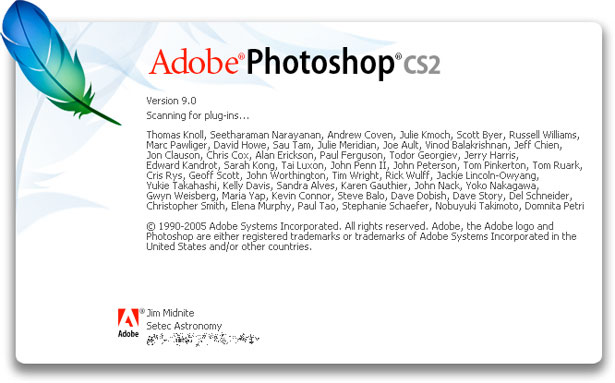
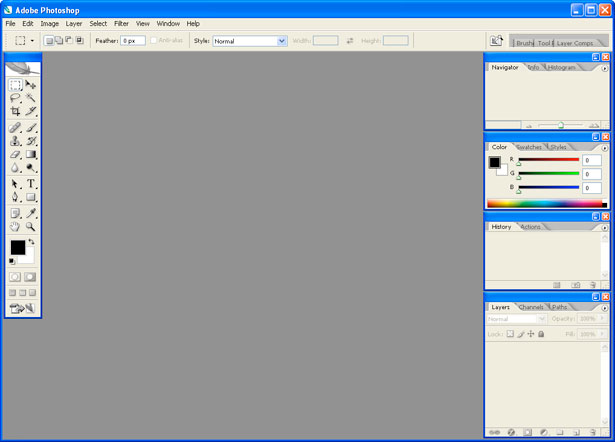
2007 - Photoshop CS3
A faster load was probably the most noticeable feature of this 2007 release. It included fine tuning to a number of its existing tools rather than focusing on new ones.
The most notable new feature was graphic optimization for mobile devices, a feature which many web designers focusing on mobile design were thankful for. This version also saw significant feature updates to Adobe Camera RAW, a Quick Select tool, alterations to core commands like Brightness and Contrast and Black and White conversion.
CS3 shipped in Standard and Extended editions. The Extended version was intended for high end video and scientific users. Improved performance for Intel-based Macs significantly improved the speed of Photoshop, while Windows users also enjoyed performance upgrades. The new Quick Selection tool put the rest of the selection tools in Photoshop to shame with easy object selection with one or two strokes.
Cloning became easier in CS3 with the birth of the Clone Source palette which increased the options available to the Clone Stamp tool in an easily accessible palette.
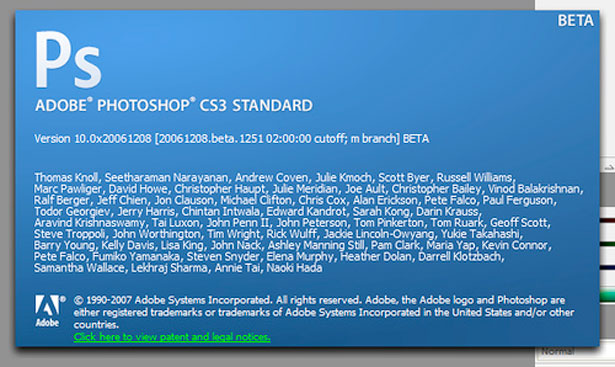
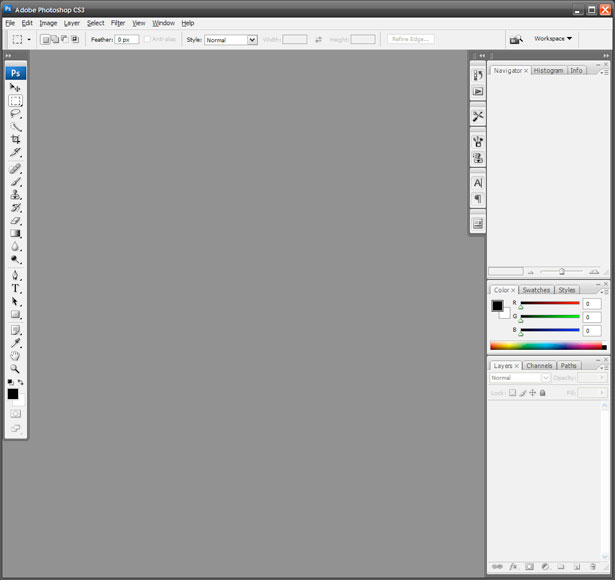
2008 - Photoshop CS4
The smoother pan and zoom allowed for fast drill down on the areas of an image that you wanted to look at. Prior to this, there was a lag time of a few seconds (depending on your system) if you wanted to zoom in or out on an image.
The Masks and Adjustments panel was added, making working with masks easier. CS 4 also dealt with edges on masks more effectively. Colour correction took a huge step forward with this release.
The user interface was significantly simplified in CS4. The support of tabbed documents made it much easier to use and the main tools were added to the title bar for easier access. Quick access for common actions was made available in the panel area.
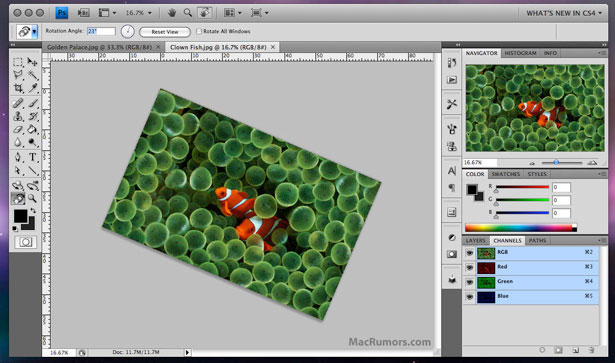
Where Are The Knolls Now?
Thomas Knoll
Thomas was the lead developer of Photoshop right up until CS 4. He now leads up the Camera Raw plugin for Photoshop, which allows Photoshop to develop a smooth handshake between different models of camera raw image formats.
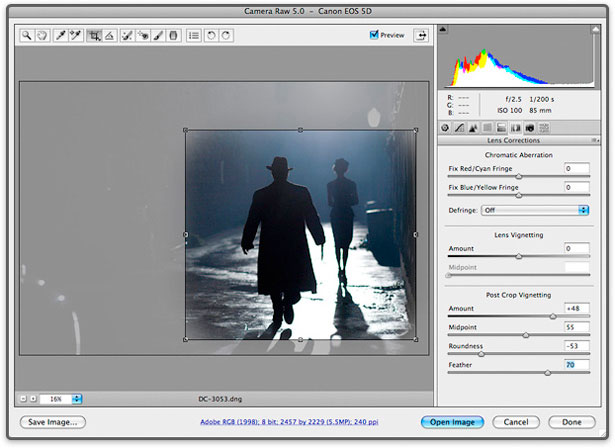
John Knoll
John is still employed by Industrial Light and Magic as a Visual Effects Supervisor. He was the Visual Effects Supervisors for the recent efforts on the first three Star Wars prequel films. He also supervised work on two Star Trek movies, Star Trek episodes, and the Pirates of the Caribbean movies.
Glenn Knoll
Their father is a teacher at the University of Michigan in the Engineering Department.
Let's all get together to wish Photoshop a Happy Birthday!
Resources
- From Darkroom to Desktop - How Photoshop Came to Light
Derrick Storyje - Guidebook Gallery
Photoshop Section - 10 Years of Photoshop
by Jeff Schewe, the artist who designed most of their splash screens.
Written and compiled exclusively for WDD by Angela West.
How has Photoshop impacted your design career over the years? Share your experiences and let us know which version you first cut your teeth on.
















